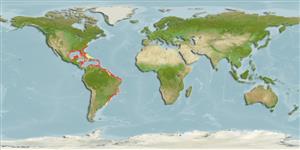>
Anguilliformes (Eels and morays) >
Muraenidae (Moray eels) > Muraeninae
Etymology: Gymnothorax: Greek, gymnos = naked + Greek, thorax, -akos = breast (Ref. 45335).
More on author: Agassiz.
Environment: milieu / climate zone / depth range / distribution range
Ecologia
marino; salmastro associati a barriera corallina; distribuzione batimetrica 1 - 160 m (Ref. 9710), usually 1 - 100 m (Ref. 42064). Tropical
Western Atlantic: Greater Antilles, including the Central American coast from Nicaragua to northern coast of South America.
Size / Peso / Age
Maturity: Lm ? range ? - ? cm
Max length : 90.0 cm TL maschio/sesso non determinato; (Ref. 57911); common length : 40.0 cm TL maschio/sesso non determinato; (Ref. 6077)
Regularly spaced blackish spots on dorsal fin; anal fin with a series of black and white areas; gill opening roundish and located on midside of body; corner of mouth and gill-opening not black (Ref. 13608).
A solitary species (Ref. 26340) commonly found on deep soft bottom areas and banks, rarely on coral reefs (Ref. 9710). Also in estuaries and lagoons (Ref. 42064). Feeds mainly on crustaceans (Ref. 42064). Probably consumed fresh or salted (Ref. 3255).
Life cycle and mating behavior
Maturities | Riproduzione | Spawnings | Egg(s) | Fecundities | Larve
Reproduction probably similar to Gymnothorax funebris (Ref. 42064).
Claro, R., 1994. Características generales de la ictiofauna. p. 55-70. In R. Claro (ed.) Ecología de los peces marinos de Cuba. Instituto de Oceanología Academia de Ciencias de Cuba and Centro de Investigaciones de Quintana Roo. (Ref. 26340)
IUCN Red List Status (Ref. 130435)
Threat to humans
Harmless
Human uses
Pesca: scarso interesse commerciale
Strumenti
Special reports
Download XML
Fonti Internet
Estimates based on models
Preferred temperature (Ref.
123201): 21.4 - 28, mean 25.9 °C (based on 1234 cells).
Phylogenetic diversity index (Ref.
82804): PD
50 = 0.5000 [Uniqueness, from 0.5 = low to 2.0 = high].
Bayesian length-weight: a=0.00045 (0.00028 - 0.00072), b=3.30 (3.17 - 3.43), in cm total length, based on LWR estimates for this species & Genus-body shape (Ref.
93245).
Trophic level (Ref.
69278): 4.1 ±0.71 se; based on food items.
Resilienza (Ref.
120179): Basso, tempo minimo di raddoppiamento della popolazione 4.5 - 14 anni (Preliminary K or Fecundity.).
Fishing Vulnerability (Ref.
59153): High vulnerability (56 of 100).
Nutrients (Ref.
124155): Calcium = 25.8 [14.0, 53.6] mg/100g; Iron = 0.415 [0.245, 0.796] mg/100g; Protein = 19 [17, 22] %; Omega3 = 0.13 [0.06, 0.36] g/100g; Selenium = 52.5 [27.0, 102.7] μg/100g; VitaminA = 58.1 [17.2, 212.8] μg/100g; Zinc = 0.997 [0.697, 1.396] mg/100g (wet weight);
